High Pressure Sodium (HPS) grow lights have produced excellent quality yields for growers for a long time. However, LED grow lights have been improving in spectrum, efficiency and cost.
Is it time to consider upgrading from HPS to LED grow lights?
To compare LED and HPS grow lights we need to define what a good grow light is.
The best grow light will deliver the highest yield & quality crop for the best price.
To determine which is best the LED & HPS grow lights are compared for:
- Spectrum output
- PAR output
- Cost
- Efficiency and heat
- Yield quality
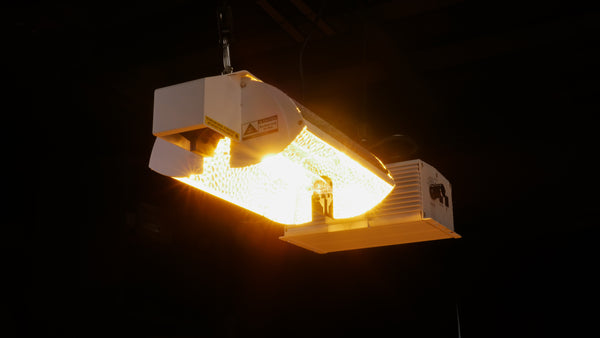
We compare the best HPS grow light money can buy: a 1,000W double ended HPS fixture with digital ballast and pro reflector.
It will be compared against the MIGRO ARAY 5X5 750W LED grow light.
A number of characteristics will be compared using test data and supporting research from Utah State University and the research team of Dr Bruce Bugbee. Dr Bugbee is the foremost research scientist publishing data from grow experiments on medicinal herbs in the world.
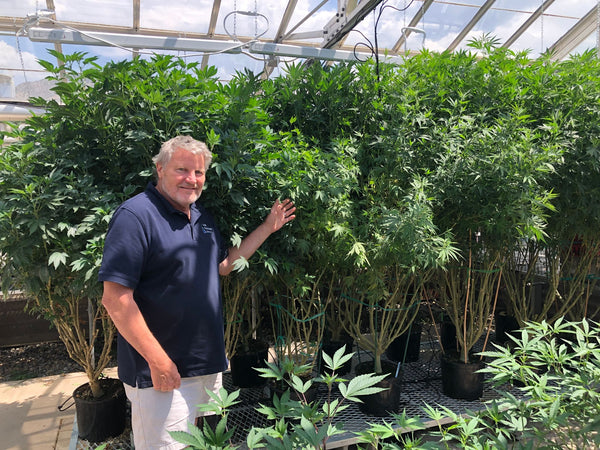
HPS Vs LED Spectrum comparison
The spectrum output of the HPS and LED grow light were tested with the Apogee M100 Spectroradiometer. Each light was analysed for the quantity of different wavelengths or colours of light.

The spectrum output of sunlight vs LED and HPS grow lights is displayed in proportions of different colors of light.
Grow light spectrum can affect the shape of a plant and rate of growth. Each color or band of wavelengths has different effects on plant growth and development.
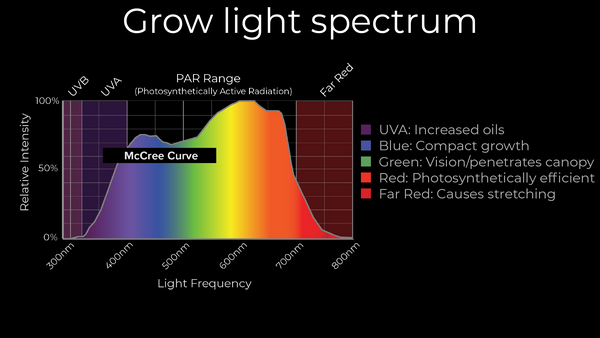
UVA increased oils
The addition of UVA and UVB can increase the production of oils in the plant and improve yield quality. UVA is photosynthetic at higher wavelengths but at relatively low efficiency compared to the PAR range. UVA effects plant shape the same as blue does i.e. it keeps plants short and dense
Neither the LED or HPS grow light output UVA or UVB in their spectrum.
If you want to add UVB and UVA effectively you must use a supplemental source such as the: MIGRO UVB 310 grow light
Blue causes compact growth
Blue light can inhibit stem elongation, promoting compact and sturdy plant growth. This is especially important for preventing leggy or spindly growth in indoor plants. Less than 5% blue light in the spectrum will result in very 'stretchy' or tall plants which are not desirable in an indoor growing environment. Increasing the percentage of blue in the spectrum to about 15% will reduce plant height. However increasing the proportion of blue will not reduce plant height much further.
The LED grow light outputs more blue and is therefore better for producing short and dense growth.
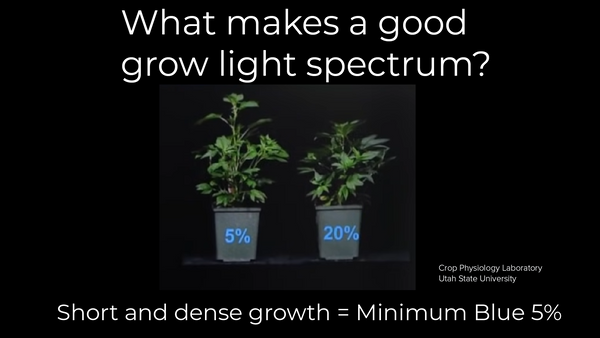
Green penetrates canopy
Green light penetrates deeper into the leaves and the canopy of plants into lower leaves that might not receive as much blue or red light. These lower leaves can still contribute to photosynthesis, enhancing overall plant productivity.
Both LED and HPS grow lights emit green light.

Red is photosynthetically efficient
Red light, with wavelengths ranging from approximately 600 to 700 nanometers, is a critical component for plant growth. Red photons are the most photosynthetically efficient of all. Indoor growers want the maximum amount of red possible in the grow light spectrum.
HPS emits slightly higher proportion of red light and is therefore higher in photosynthetically efficient.
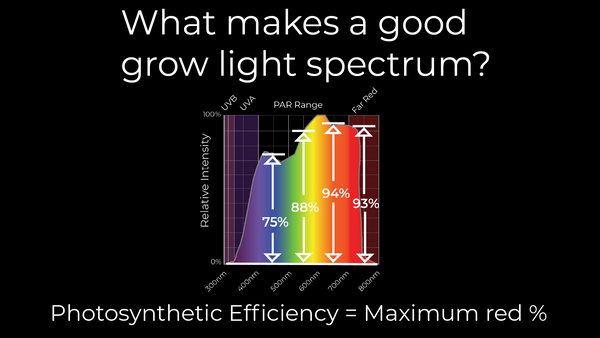
Far Red causes stretching
Far red at high proportions (in excess of 5%) in the grow light spectrum can cause plant stretching by increasing the internodal distances or the distance between branches. However it can also cause leaf expansion i.e. larger leaves which may be beneficial in early veg to expand the canopy at a faster rate to capture more light.
HPS emits a higher proportion of far red light which will promote stretched plants which is undesirable.
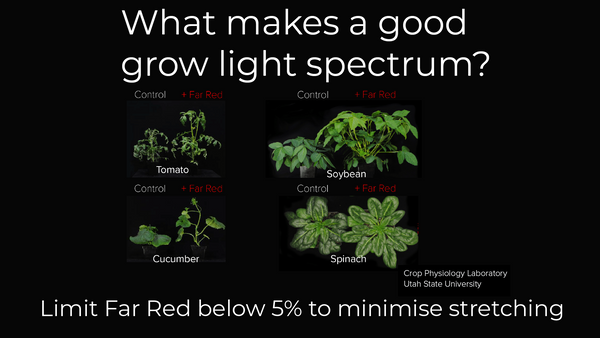
LEDs provide a better quality light for visual inspection of the plants
LED light quality is better for inspecting the health of your plants. The orange light from a HPS fixture is not ideal for identifying nutrition deficits, pests or disease.
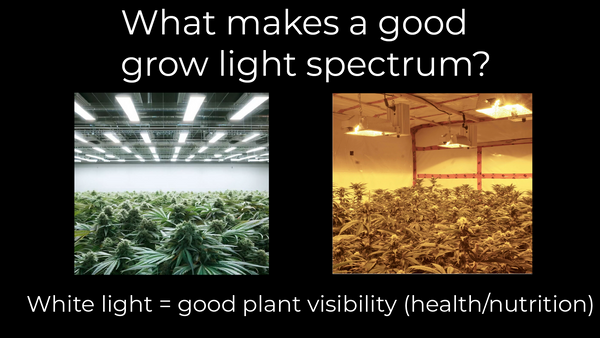
LED Vs HPS spectrum analysis summary
The LED spectrum has more blue and less far red than HPS so will promote more short and dense growth. Neither grow light has UVA in its spectrum output. HPS has slightly more red than LED in the spectrum output and is theoretically slightly more photosynthetically efficient. However studies of the same PAR intensity but with different spectrum produced the same yield with medical plants (allowing for a % error in the result).
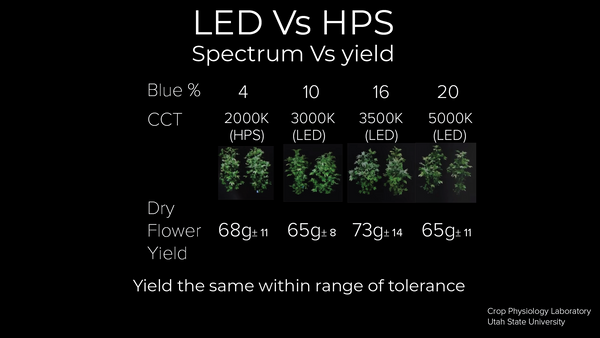
LED Vs HPS PAR output
The LED and HPS fixture were each tested for PAR output (Photosynthetically Active Radiation) in a 5ft x 5ft or 1.5m x 1.5m area with reflective walls.
The fixtures are each hung at their optimum hanging heights. They are hung as low as possible to minimise reflectance losses but not too low to cause hot spots underneath. Hanging too low will also reduce the light reaching the corners.
LED Vs HPS PAR chart comparison
One hundred measurements of ePAR intensity were recorded in a grid across the test area (ePAR measures from 400 - 750nm to include far red).
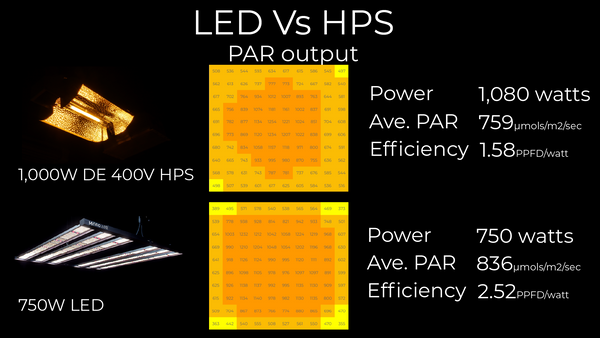
Even though the LED fixture consumes 30% less power than the HPS fixture it delivers 10% more PAR to the plant canopy.
The LED grow light is 60% more efficient in terms of PAR output per watt than the most efficient HPS grow light on the market.
The light intensity is also more evenly distributed with the LED grow light.
LED can achieve much higher PAR intensity
Even the most efficient 1,000W HPS grow light in a 5ft x 5ft or 1.5m x 1.5m area generates a lot of heat. So much so it is not feasible to add more HPS watts in that size space without causing heat stress. As LED grow lights are much more efficient we can increase PAR intensity much higher than with HPS.
Recent studies show that PAR intensity can be increased 50% from an average of 800 µmols to an average of 1,200 µmols and get almost 40% increase in growth rate and yield. This means getting much higher yields with LED vs HPS in the same sized space.
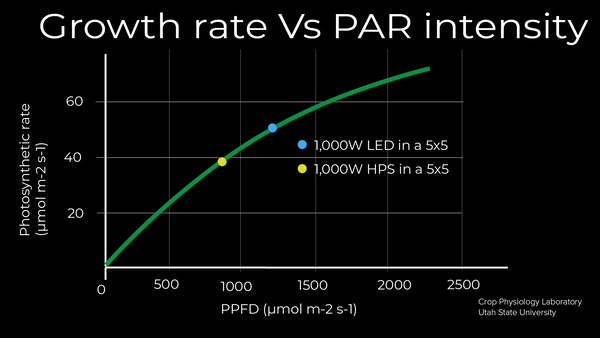
Lower hanging height with LED grow lights
HPS grow lights must be hung about 2.5ft or 75cm above the plant canopy to prevent hot spots underneath them. LED bar grow lights can be hung as low as 10 inches or 25cm above the plant canopy. This is because the LED light source is more spread out than the HPS fixture and LEDs do not emit as much radiated heat as the HPS does.
The HPS fixtures must also have more room above them for airflow than LEDs.
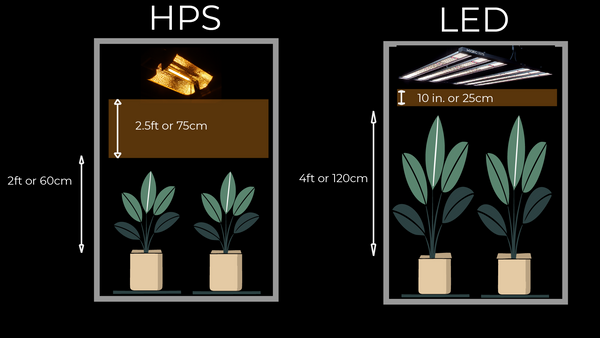
For both of these reasons LED grow lights require less hanging height and allow much more vertical space for plants to grow in your grow tent.
LED Vs HPS cost
The comparison charts below use the results from the PAR output and efficiency tests to calculate and compare the total cost of each fixture to deliver an average PAR of 800µmols/m²/second over a 5ft x 5ft grow area over a 3 year period.
The 3 year costing includes the cost of the fixture and adds the electricity costs at 16.8c/KW hour over 12 hours per day average for the US comparison and 29c/KW hour for the EU comparison.


LED Vs HPS grow lights heat output

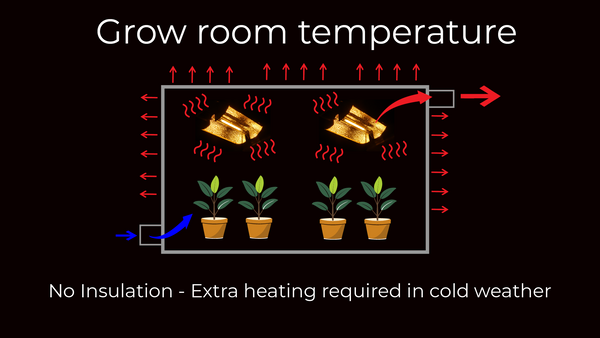

LED Vs HPS yield quality
Quality of the harvest will mostly be determined by plant genetics, nutrients and environment. However there are two ways lighting can contribute to yield quality.
The first benefit is higher light intensity increases bud density and frostiness. LEDs can delivery higher average light intensity than HPS due to its high efficiency. It can also spread that PAR more evenly so all the bud sites develop the same quality.
The second benefit is the reduced radiated heat from LEDs. HPS grow lights emit a lot of radiated heat which will increase the bud tip temperatures close to the light source.
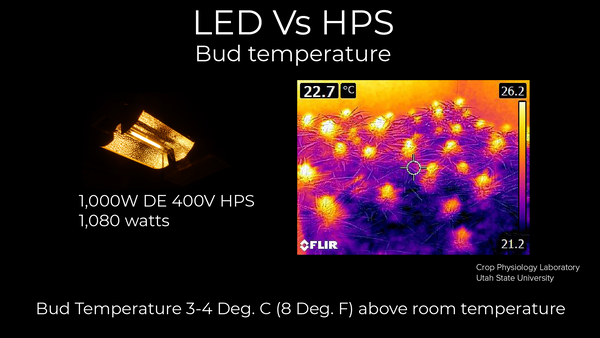
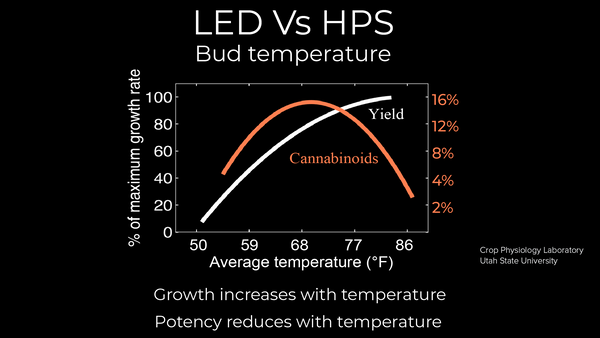
It is much easier to maintain lower bud temperatures with a relatively higher room temperature with LED grow lights.
LED Vs HPS Summary
LED grow lights have increased in efficiency and reliability while also reducing in cost.
The benefits of LED grow lighting over HPS technology includes:
- The payback in investing in LED grow lights is now less than a year for most growers
- Better spectrum with higher proportion of blue light for short and dense growth
- 60% more PAR output per watt than the most efficient HPS grow light on the market.
- Higher PAR intensity can be delivered with LED due to the reduced heat output
- Deliver higher quality yield with reduced bud temperatures while maintaining a higher grow room temperature for higher yield mass.















